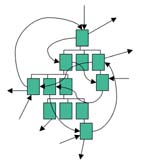The power of the Web comes from the fact that by adding hyperlinks to a web page and pointing to other web pages, web designers can enable you to move in any direction – from one page up to another page on a higher level, sideways to a page on the same level, down to a page  lower on the organisational structure, or over or across to a web page that is part of another web site on another computer somewhere else in the world.
lower on the organisational structure, or over or across to a web page that is part of another web site on another computer somewhere else in the world.
This ability to link or jump in any direction (up, down, sideways or across) means that you as user are not forced to follow a hierarchical (or linear) structure as is so often the case with other media, but can jump around in a manner that pleases you (choice is an important advantage of the Web).
 When you start interacting with the Web, the interface you work through is a software program called a web browser. The web browser is essentially your ‘window’ to the world of the Web. Today the two most common web browsers are Microsoft’s Internet Explorer which has the largest share of the market, followed by Netscape Communicator.
When you start interacting with the Web, the interface you work through is a software program called a web browser. The web browser is essentially your ‘window’ to the world of the Web. Today the two most common web browsers are Microsoft’s Internet Explorer which has the largest share of the market, followed by Netscape Communicator.
Hyperlinks – allowing you to move from web page to web page in a non-linear fashion.
Looking for ISP’s in SA?
|